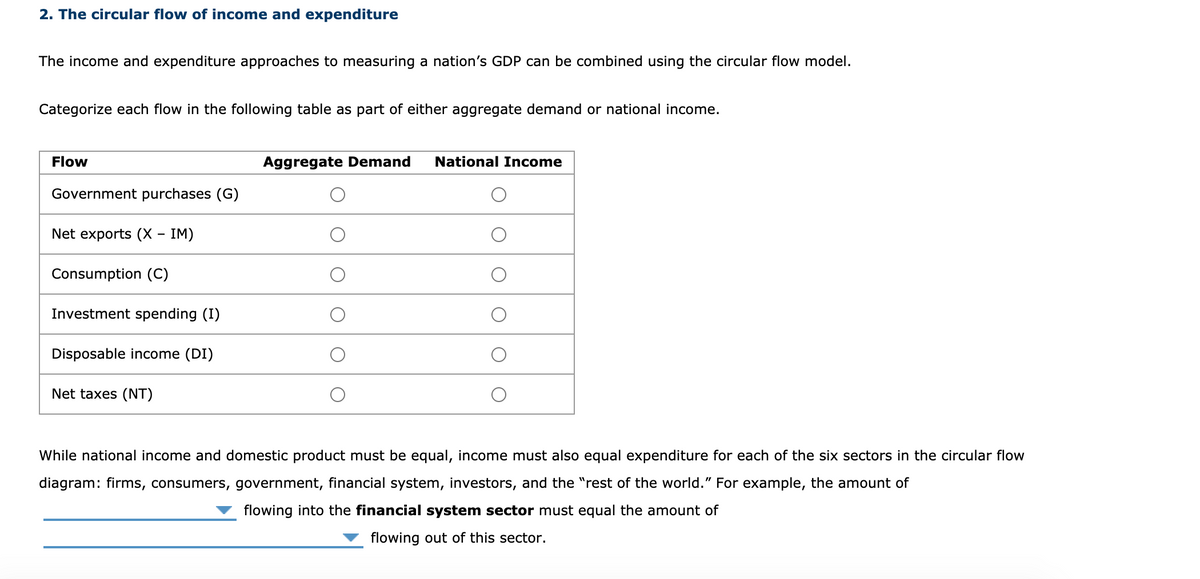2. The circular flow of income and expenditure The income and expenditure approaches to measuring a nation's GDP can be combined using the circular flow model. Categorize each flow in the following table as part of either aggregate demand or national income. Flow Aggregate Demand National Income Government purchases (G) Net exports (X - IM) Consumption (C) Investment spending (I) Disposable income (DI) Net taxes (NT) While national income and domestic product must be equal, income must also equal expenditure for each of the six sectors in the circular flow diagram: firms, consumers, government, financial system, investors, and the "rest of the world." For example, the amount of flowing into the financial system sector must equal the amount of ▼ flowing out of this sector.
2. The circular flow of income and expenditure The income and expenditure approaches to measuring a nation's GDP can be combined using the circular flow model. Categorize each flow in the following table as part of either aggregate demand or national income. Flow Aggregate Demand National Income Government purchases (G) Net exports (X - IM) Consumption (C) Investment spending (I) Disposable income (DI) Net taxes (NT) While national income and domestic product must be equal, income must also equal expenditure for each of the six sectors in the circular flow diagram: firms, consumers, government, financial system, investors, and the "rest of the world." For example, the amount of flowing into the financial system sector must equal the amount of ▼ flowing out of this sector.
Chapter6: Tracking The U.s. Economy
Section: Chapter Questions
Problem 1.2P
Related questions
Question
The income and expenditure approaches to measuring a nation’s GDP can be combined using the circular flow model.

Transcribed Image Text:2. The circular flow of income and expenditure
The income and expenditure approaches to measuring a nation's GDP can be combined using the circular flow model.
Categorize each flow in the following table as part of either aggregate demand or national income.
Flow
Aggregate Demand
National Income
Government purchases (G)
Net exports (X – IM)
Consumption (C)
Investment spending (I)
Disposable income (DI)
Net taxes (NT)
While national income and domestic product must be equal, income must also equal expenditure for each of the six sectors in the circular flow
diagram: firms, consumers, government, financial system, investors, and the "rest of the world." For example, the amount of
flowing into the financial system sector must equal the amount of
flowing out of this sector.

Transcribed Image Text:Categorize each flow in the following table as either an injection into the circular flow or a leakage from the circular flow.
Flow
Injection
Leakage
Saving (S)
Net taxes (NT)
Exports (X)
Investment spending (I)
Government purchases (G)
Imports (IM)
Expert Solution
This question has been solved!
Explore an expertly crafted, step-by-step solution for a thorough understanding of key concepts.
This is a popular solution!
Trending now
This is a popular solution!
Step by step
Solved in 2 steps

Knowledge Booster
Learn more about
Need a deep-dive on the concept behind this application? Look no further. Learn more about this topic, economics and related others by exploring similar questions and additional content below.Recommended textbooks for you


Brief Principles of Macroeconomics (MindTap Cours…
Economics
ISBN:
9781337091985
Author:
N. Gregory Mankiw
Publisher:
Cengage Learning

Essentials of Economics (MindTap Course List)
Economics
ISBN:
9781337091992
Author:
N. Gregory Mankiw
Publisher:
Cengage Learning


Brief Principles of Macroeconomics (MindTap Cours…
Economics
ISBN:
9781337091985
Author:
N. Gregory Mankiw
Publisher:
Cengage Learning

Essentials of Economics (MindTap Course List)
Economics
ISBN:
9781337091992
Author:
N. Gregory Mankiw
Publisher:
Cengage Learning

Principles of Economics 2e
Economics
ISBN:
9781947172364
Author:
Steven A. Greenlaw; David Shapiro
Publisher:
OpenStax

